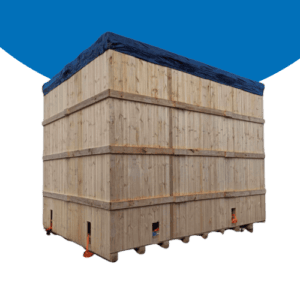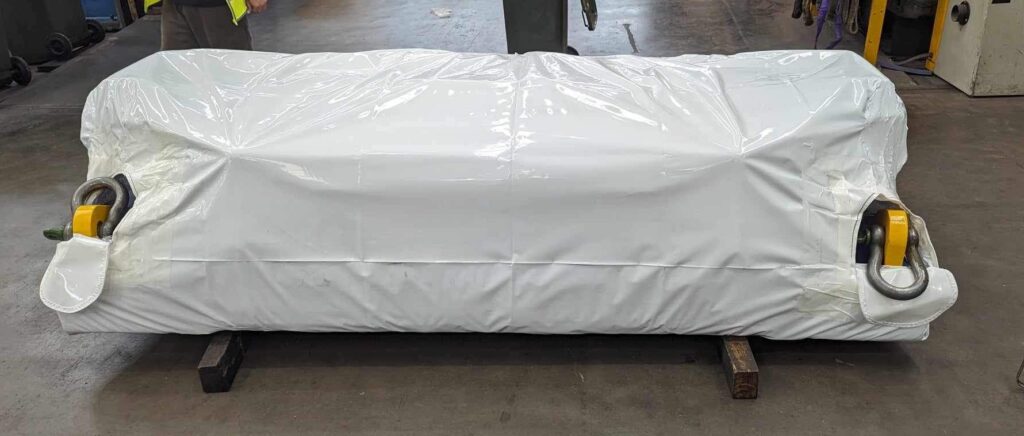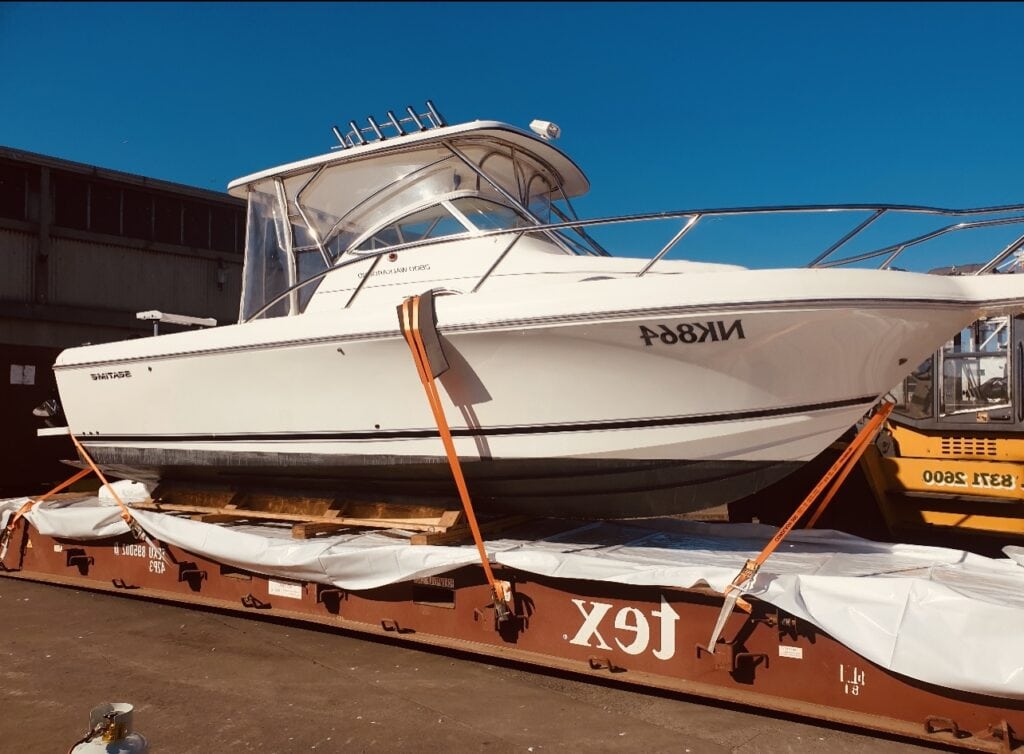Stretch wraps, also known as stretch films, serve an important purpose in many different types of businesses as a means of packing and fastening. This thin, malleable plastic film is designed to wrap snuggly around objects, protecting them and keeping them together throughout shipping, storage, and other handling activities.
Stretch wrapping provides numerous benefits, including keeping things secure and safe from dust, moisture, and other factors. This article delves into the many applications of a stretch wrap, shedding light on its significance in modern packaging techniques.
The primary purpose of stretch wrap is to completely encapsulate and protect items, whether they are on a pallet or not. If the film is applied correctly, it will establish a tight barrier around the products and prevent them from shifting, toppling over, or being damaged during transport. This is of utmost significance in fields where products are routinely transferred, such as loading, unloading, and long-distance transport.
A stretch wrap increases safety and decreases the likelihood of product damage by maintaining a constant load.
Stretch wraps not only secure goods but also shield it from the elements. The coating creates a tight barrier, blocking off dust, moisture, and other potentially damaging factors.
This is especially important in industries like the food, electronics, and pharmaceuticals where customer confidence in the quality of their products is paramount. Stretch wraps with tamper-evident features are useful for keeping products in their original condition and spotting any signs of tampering or opening.
Stretch wraps are eco-friendly and save you money. It reduces the price of transportation by reducing the number of boxes and crates required for transport.
Because it requires less energy and resources than standard packing methods, using a stretch wrap is consistent with environmentally friendly practises. Lightweight and easily stored, the film helps maximise shipping efficiency while cutting down on carbon emissions related with transportation.

Benefits Of Using Stretch Wrap
Stretch wrapping plays a pivotal role in the final stages of manufacturing and is the initial point of customer engagement when orders are received. Here we delve into the manifold benefits of employing stretch wrapping machines in your operations, highlighting why this investment can be a game-changer for your business.
Preserving Product Quality
One of the primary merits of using a stretch wrapping machine is the heightened level of protection it offers to goods. By tightly enveloping the products, these machines shield them from environmental detriments such as dust, dirt, and moisture, thereby maintaining their integrity.
Enhancing Workplace Safety
Stretch wrapping machines provide an added layer of safety in warehouse operations. The mechanism mandates forklift operators to remain seated, thereby reducing distractions and the likelihood of accidents involving pedestrians—known to comprise 20% of all forklift-related mishaps. Additionally, the shift from manual to automatic stretch wrapping can substantially decrease the incidence of wear-and-tear injuries amongst staff.
Time-Efficiency and Uniformity
Stretch wrapping machines are a boon when it comes to time-saving. Manually wrapping each pallet or package can be a laborious task. Automatic machines offer a quicker and more uniform approach, liberating valuable time that can be diverted to other crucial tasks.
Uniformity in wrapping also reduces the risk of packages toppling over during transit, consequently reducing damage to both the products and the handlers.
Cost-Effectiveness in Material Use

Automatic and semi-automatic stretch wrapping machines are designed to optimise film usage, thus lowering material costs. These machines employ a dual roller system that stretches the film, enhancing its tensile strength and reducing the amount required.
This technology renders automatic machines financially advantageous, especially those with rotary towers that are particularly efficient.
Augmented Packaging Speed
For businesses that deal with bulk packaging, stretch wrapping machines with PLC (Programmable Logic Controller) control are invaluable. Machines like Orion's Flex HPA are engineered to be highly adaptable, allowing for greater speed and load capacity.
Such machines can significantly elevate the pace of operations, wrapping up to 60-75 loads per hour depending on the model.
Uniformity and Efficiency in Bulk Packaging
In the realm of bulk packaging, the consistency offered by automated stretch wrapping is unparalleled. Manual wrapping often results in uneven stretch and suboptimal efficiency, jeopardising the condition in which products arrive at their destination.
Automated systems provide a far more reliable and efficient packaging solution.
Boosting Operational Productivity
Streamlining workflow is a universal objective across industries. Automatic stretch wrapping machines, which can be activated simply by placing a pallet on a conveyor or pulling a cord, eliminate bottlenecks in the wrapping process. This smoothens the operational flow, thereby enhancing productivity.
Improved Stock Management
Automated stretch wrapping enables a more streamlined approach to inventory management. Uniform and transparent wraps make it easier to group similar items, simplifying the stocktaking process and reducing the chances of errors or delays.
Regardless of your warehouse size or location, incorporating a stretch wrapping system can imbue your operations with increased consistency, safety, and efficiency. With a wide array of automated systems available in the market, this investment promises a wealth of advantages that can significantly elevate your operational efficacy.
The Practice of Stretch Wrapping
Stretch wrapping serves multiple purposes, primarily to create a uniform package for easy and efficient transportation. By consolidating individual items into a single, larger unit, the method aids in the preservation of the products during transit.
Stretch wrapping ensures that goods arrive in their original condition by minimising the risks associated with movement and potential damage en route to their destination.
In the realm of shipping, the prevention of cargo shift is crucial. Stretch wrapping contributes significantly to stabilising loads, thus reducing the odds of damage during transportation.
While other risks to cargo integrity remain, stretch wrapping decreases the incidence of return, customer service efforts, administrative chores, and credit to receivers, thereby saving both time and money.
Dating back to the 1970s, stretch wrapping has been a conventional approach to container consolidation. It is a practice well-known to industries engaged in the manufacturing, resale, or storage of goods. Understanding the mechanics and materials involved in stretch wrapping can guide businesses in making informed decisions.
Commencement of Stretch Wrapping: Pallet Loading
Prior to stretch wrapping, a load must be assembled on a pallet. The pallet and the load are then wrapped together to form a single unit. The placement of goods on the pallet is critical; the load should not exceed the pallet's edges by more than four inches, and the pallet itself must be in good condition. The effectiveness of stretch wrapping hinges upon these careful preparations.
Stretch wrapping can secure loads to pallets effectively, provided appropriate measures are taken. However, during transportation, the film can be compromised by forklifts or pallet jacks, thereby diminishing the containment force and increasing the risk of failure. Pallet Grip is an innovative method that involves coiling the bottom few inches of the film web into a sturdy cable.
This cable is inserted just beneath the pallet's top deck boards to secure the load, whilst allowing sufficient space for the forks to manoeuvre beneath.
Methods of Stretch Wrap Application
Stretch wrapping can be executed manually, semi-automatically, or via high-speed automatic stretch wrappers.
Manual Stretch Wrapping
As the term implies, manual wrapping requires human labour. A worker attaches the film to the pallet and walks around the load to apply the film. This method is physically demanding and often leads to inconsistencies in wrapping and higher material costs.
Semi-Automatic Stretch Wrapping
Semi-automatic machines come in two primary designs: turntable and straddle. With turntable models, the load rotates on a platform while the stretch film is applied. In contrast, straddle models feature a wrap arm that moves around a stationary load. This approach is ideal for loads that are either exceedingly heavy, incredibly light, or unstable.
High-Speed Automatic Stretch Wrappers
These machines bear similarities to their semi-automatic counterparts but typically incorporate conveyors to feed and remove loads during the process. Additional accessories can enhance the level of automation in semi-automatic machines, enabling forklift operators to remain seated during the wrapping process, thanks to features like an automatic film cutter and clamp and a remote start lanyard.
Stretch wrapping is a vital practice for the efficient and safe transport of goods, and understanding its intricacies can contribute to improved operational outcomes.
Conclusion
Stretch wraps, which are also called "stretch films," are important packing materials that are used in many businesses to protect and move items. They make a tight barrier around the goods so they don't move, fall over, or get damaged while being moved.
Stretch wraps are good for the environment because they cut down on the number of boxes and crates that are needed for shipping. This cuts down on carbon emissions.
By using stretch wraps, companies can keep the quality of their products, make the workplace safer, improve time efficiency and consistency, make the best use of their materials, and speed up the packaging process.
Automatic stretch wrapping machines, like Orion's Flex HPA, are faster and more consistent. This makes it less likely that packages will fall over during shipping.
They also save money on materials because automatic and semi-automatic machines use a dual roller system to increase tensile strength and decrease the amount of material used.
Automated stretch wrapping machines make bulk packaging more consistent and efficient than ever before. This makes sure that the quality of the goods stays the same when they get to their destination. They also improve business efficiency by getting rid of bottlenecks in the wrapping process and making it easier to keep track of stock.
Adding a stretch wrapping system to a building can make it much safer, more consistent, and better at what it does. Investing in a stretch wrapping system can make a big difference for your business. There are many automatic systems to choose from.
Stretch wrapping is a way to make packages that are all the same size so that they can be moved quickly and without much damage. Since the 1970s, it has been used in places like making, reselling, and storage.
In this process, a load is put on a crate and wrapped up to make a single unit. Stretch wrapping works best when it is put in the right place and done the right way.
The Pallet Grip is a new way to make sure that loads stay on pallets. Stretch wrapping can be done by hand, semi-automatically, or with high-speed automatic stretch wraps.
Manual packing takes work from a person and can lead to mistakes and higher costs for the materials. Machines that are only partly automatic, like turntable and straddle types, work well with heavy, light, or unstable loads.
High-speed automatic wrappers often have rollers and other parts to make them more automated. Learning about stretch wrapping can help with operations and make sure that things are transported safely and quickly.

Content Summary
- Stretch wrap serves as an essential tool in various industries for packaging and securing items.
- The malleable plastic film wraps tightly around objects, safeguarding them during shipping and storage.
- The primary function of stretch wrap is to encapsulate and protect items, preventing damage during transit.
- Utilising stretch wrap enhances the safety of goods by maintaining a consistent load.
- The film also acts as a barrier against environmental factors like dust, moisture, and dirt.
- This is particularly crucial in the food, electronics, and pharmaceutical industries, where product quality is paramount.
- Tamper-evident features in stretch wraps add an extra layer of security, making any interference easily detectable.
- Using stretch wrap is environmentally friendly and aligns with sustainable practices.
- Stretch wrap can reduce transportation costs by minimising the need for boxes and crates.
- Lightweight and easy to store, stretch wrap enhances shipping efficiency.
- Stretch wrapping machines offer improved protection against environmental hazards like dust and moisture.
- These machines play a vital role in the last stage of manufacturing and are the first point of contact when customers receive their orders.
- Stretch wrapping machines significantly enhance workplace safety by mandating that forklift operators remain seated.
- This reduces the risk of accidents involving pedestrians, who account for 20% of all forklift-related incidents.
- Switching to automatic stretch wrapping can lower the incidence of wear-and-tear injuries among staff.
- Time efficiency is a significant advantage of using stretch wrapping machines.
- Automatic machines deliver uniform wrapping, reducing the risk of packages toppling over during transport.
- Stretch wrapping machines optimise film usage, lowering material costs.
- These machines use a dual roller system to stretch the film, enhancing its tensile strength.
- PLC-controlled stretch wrapping machines, such as Orion's Flex HPA, can handle a high volume of wrapping tasks efficiently.
- These machines can wrap up to 60-75 loads per hour, depending on the model.
- Automated systems provide unmatched uniformity and efficiency in bulk packaging.
- Adopting automated stretch wrapping can streamline workflow and enhance productivity.
- Uniform wraps aid in better stock management, making stocktaking more straightforward.
- Transparent wraps simplify the process of grouping similar items.
- Regardless of warehouse size or location, stretch wrapping systems offer increased consistency, safety, and efficiency.
- Stretch wrapping serves to create a uniform package, aiding in the preservation of products during transit.
- The method minimises risks associated with movement and potential damage en route to their destination.
- It plays a crucial role in stabilising loads and reducing the likelihood of damage during shipping.
- Stretch wrapping has been a conventional approach for container consolidation since the 1970s.
- Proper pallet loading is essential for effective stretch wrapping.
- During transport, film can be compromised by forklifts, making proper application crucial.
- Pallet Grip is an innovative method for securing loads to pallets effectively.
- Stretch wrapping can be executed manually, semi-automatically, or via high-speed automatic stretch wrappers.
- Manual wrapping is physically demanding and often results in inconsistencies.
- Semi-automatic machines come in two designs: turntable and straddle.
- Turntable models rotate the load on a platform while applying the stretch film.
- Straddle models feature a wrap arm that moves around a stationary load.
- High-speed automatic stretch wrappers incorporate conveyors to feed and remove loads.
- These machines often include features like an automatic film cutter and clamp.
- A remote start lanyard enables forklift operators to remain seated during the wrapping process.
- Stretch wrapping contributes to reduced customer service efforts by minimising the incidence of returns.
- It also saves administrative time and effort, thereby saving money.
- The film is lightweight and cuts down on carbon emissions related to transportation.
- Employing stretch wrap is consistent with environmentally friendly practices.
- Enhanced tensile strength in film is achieved through a dual roller system in automated machines.
- Investing in a stretch wrapping machine can be a game-changer for businesses in various sectors.
- Uniform and transparent wraps make it easier to scan items, streamlining inventory processes.
- Incorporating a stretch wrapping system promises a wealth of operational advantages.
- Understanding the intricacies of stretch wrapping can significantly improve operational outcomes.
Frequently Asked Questions
Stretch wrap loads are more secure which minimizes shipping damages. UVI stretch films can protect products stored outdoors from UV rays. Strong opaque films conceal load contents and reduce instances of pilferage. Stretch films keeps products free of dust, moisture and dirt.
Stretch wrap can be applied by hand or machine, depending on the job. The gauge is the measure of the wrap's thickness, which varies depending on purpose. Generally the higher the gauge, the higher its resistance to breakage. General-purpose 80-gauge wrap is the industry standard, and can secure loads up to 2,400 lbs.
Stretching keeps the muscles flexible, strong, and healthy, and we need that flexibility to maintain a range of motion in the joints. Without it, the muscles shorten and become tight. Then, when you call on the muscles for activity, they are weak and unable to extend all the way.
Stretch wrapping is mostly associated with covering products for deliveries and in warehouses. It is mainly used by factories and product manufacturers to keep products safe and securely packaged.
The short answer is yes. Stretch film is generally made with linear low density polyethylene (LLDPE) which is denoted as category four in recycling programs. For many plastics the real world answer is more complex.


